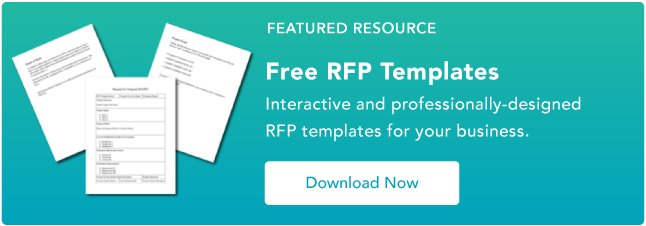Presenting a proposal is the culmination of a large amount of time and work. The last thing you want to do is to make mistakes that can cause you to lose deals. I have been in sales for more than a decade now and have definitely learned vital lessons the hard way.

Here are four tips I’ve put together to help you present powerful proposals to close even the toughest deals:
Download Now: Free RFP Templates
1. Put Yourself in Your Client’s Shoes
This seems cliché, but you would be surprised how many prospects I have acquired over time because they felt I stood out as the only one who truly understood their goals, the challenges they face, and their vision.
Start this process in the discovery meeting prior to presenting the proposal. Take the time to understand your client’s organization structure, concerns, goals, industry, and competition. Who are the major decision-makers and stakeholders? What would happen if this endeavor fails? What are the company's main products or services? How is the company better or worse than that of its competitors? What marketing activities has it tried in the past? What worked? What didn’t?
Once you have a good understanding of your client’s situation, make it a point to communicate the general plan and a ballpark budget verbally in the first or second meeting. This will give you a rough idea on where the client stands when it comes to your ideas and pricing model. This will also keep you from wasting time writing proposals for a brand that is not compatible with what you can deliver and what the client should expect.
2. Get The Decision-Makers to Attend the Meetings
If you have been in sales long enough, you know your chances of closing a sale goes up if you can talk directly to the decision-makers. Usually, if your point of contact functions as an influencer or the information gatherer, it’s a bit challenging to get him to agree to bring the primary decision-makers to the meeting.
Try your best to get the decision-makers to attend the discovery meeting, and more importantly, the proposal review meeting. Be careful not to vex your point of contact in the process. If he stringently insists that this request is just not possible, move forward, and present your proposal with your point of contact.
3. Pull Examples From Your Previous Successes
The people responsible for hiring your services for their company will be held accountable for choosing you. If they make the wrong decision and the project fails, it will hurt their career and might cost them their job or position. If your client is the business owner himself, he is running the risk of losing his capital or market share in the event you fail to deliver.
With this mind, providing examples of your past success makes both the information gatherers and the decision-makers feel comfortable that you can deliver the items you have discussed in your proposal. I usually show examples of every item included in the marketing strategy in my proposal as I review respective sections of the proposal.
Providing examples also help greatly when it comes to explaining strategies to clients who are not marketing savvy. It allows them to understand your points, visualize the solutions you are offering, and understand the possible outcomes of your plan.
4. Speak on Your Client’s Level
You will talk to different types of people with different levels of marketing knowledge. Be sure to identify this early on. If you are talking to a business owner who has no prior marketing experience, take it slow. Avoid jargons — especially if you can't even explain what they mean and how it will benefit your clients. They may nod their heads like they understand, but clients often feel overwhelmed and lost.
On the other hand, if you are speaking to a seasoned CMO, you will need to talk on a higher level and avoid the risk of insulting him by explaining simple concepts that he may already know. Permit him to stop you at any time if you are explaining something he comprehends well.
Presenting proposals to prospective clients is no easy task. The most important thing to remember is to be confident, calm, and poignant. Do your research thoroughly, and come to your meetings prepared. Be realistic with what you can deliver and what the clients can expect.

![What is a Marketing Proposal, and How Can You Create One? [Template Included]](https://www.hubspot.com/hubfs/marketing%20proposals-1.jpg)

![8 Best Tips for Business Proposal Presentations [+Examples]](https://www.hubspot.com/hubfs/business-proposal-presentations.jpeg)





![Bidsketch Gives Agencies the Tools to Create Proposals — Fast [Tech Profile]](http://cdn2.hubspot.net/hub/53/file-1520221479-jpg/blog-files/ruben.jpg)
